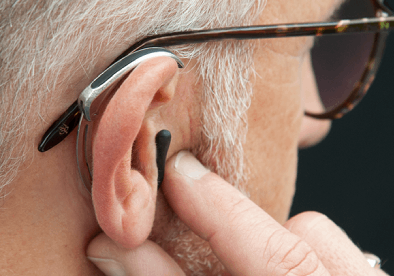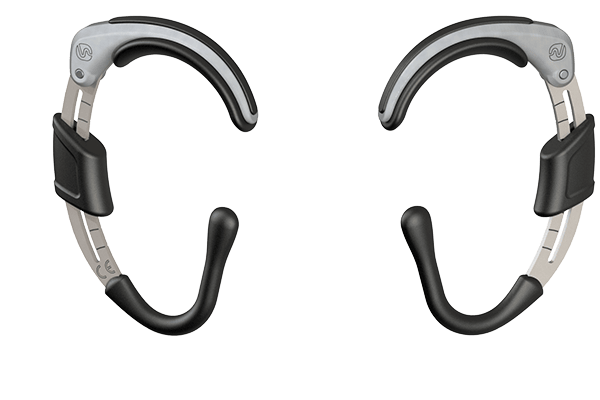
Forgtin
Reducing Tinnitus with 3D Printing
Chronic tinnitus is often a never-ending torture for those affected. However, the Austrian inventor Klaus Grübl has recently developed a medical aid that can help patients, with support from digital manufacturing specialist Protolabs.
Whistling, hissing or whooshing - 24 hours a day, 7 days a week. This is the bitter reality for those with tinnitus aurium. 15 percent of the population are affected by so-called phantom noises at least once in their life and, for many sufferers, chronic tinnitus is a constant companion to everyday life. The consequences can vary depending on the exact clinical picture, but this untreatable condition often causes sleep disorders, unfitness for work and depression.
As contradictory as it sounds in view of the clinical picture, tinnitus is usually an acquired condition - regardless of the various causes that can lead to the phantom noises. Subjective tinnitus (the form in which no physical sound sources cause background noise) is a complaint that usually arises in the auditory cortex in the brain. A triggering event, for example acoustic shock or sudden hearing loss, can lead to previously healthy synaptic connections losing their actual purpose and causing tinnitus through abnormal activity. The resulting persistent neuronal firing becomes firmly established in some people and chronic tinnitus becomes a self-acquired annoying background.
From Self-help to External Help
Klaus Grübl was himself affected by chronic tinnitus for a long time. The entrepreneur, who actually comes from the field of adult education, has lived with tinnitus for 19 years, which included a constant whistling which didn't go away. In a quiet moment, when Grübl became particularly aware of tinnitus due to the lack of ambient noise, he began to apply constant pressure for several minutes to a certain point of the ear. After a while he found the sound became noticeably quieter. Spurred on by this initial success, Grübl began the very next day to pursue his assumption that there might be a connection between the pressure exerted and the improvement in symptoms. A short time later, he incorporated an initial prototype into his everyday life which was attached to his glasses and exerted pressure at three points on the ear - and the tinnitus disappeared completely.
| At A Glance |
|---|
|
Create a wearable device that limits the effects of tinnitus by applying pressure to points around the ear.
Utilise 3D printing, direct laser sintering and injection moulding to create the detailed pieces need to form Forgtin the device in as short a time as possible.
From the initial enquiry through to starting production, Klaus was able to move the Forgtin project forward in as little as eight weeks. |

Grübl explains that the reason for the sudden success with this form of therapy is down to the primary cause of the symptoms. The pressure exerted on the various points on the ear stimulates the corresponding region in the auditory cortex which is also responsible for chronic tinnitus. The synaptic connections that cause the unpleasant noise are less stressed and the brain slowly forgets the actual cause of the whistling sound.
Spurred on by this initial success, Klaus Grübl founded Pansatori GmbH which was to further develop, produce and ultimately sell the new product ForgTin – an abbreviation of Forget Tinnitus. It has been over a year since then and one non-clinical study has already been conducted; a medical study will follow and ForgTin is about to launch in the market.
Grübl is convinced of the potential of his invention: “In our first study with 20 patients, the participants’ subjectively perceived tinnitus decreased by between 30 and 100 percent. Building on these results, a clinical study is now also planned to further investigate the effectiveness of ForgTin. In the meantime, we are about to launch our product and I look forward to being able to help the first patients this autumn.”
Alliance Against Tinnitus
From the original concept to the finished product, a lot of engineering and design went into ForgTin. While the initial prototypes, which Grübl and his designer and constructor made using 3D printers at home, were made of plastic and were non-flexible, Pansatori GmbH soon began to work with professional 3D printing service providers. During this part of the project, contact was established with manufacturing service provider Protolabs, a company specialising in additive manufacturing and the manufacture of prototypes in the medical sector amongst other things. “It was clear to us early on that there was no getting around 3D printing. ForgTin consists of complex geometries and must ultimately be customisable and adaptable so that anyone affected can use the device,” explains Grübl. “Together with my designer, I first came across Protolabs in July 2020. After initial contact in mid-July, work started right away.”
Overall ForgTin consists of several individual parts that Grübl designed together with his developer. Behind the outer ear lies the upper bracket which, like an earpiece on spectacles, holds ForgTin in position and covers one of the pressure points. The upper bracket is connected to the lower one by a split pin which leads past the earlobe to the tragus (prominence) in front of the external auditory canal. Here, and behind the ear, there are also the two additional pressure points which combat tinnitus by applying constant pressure. Finally, ForgTin is rounded off with silicone elements which are essential for wearing comfort. “Immediately after we uploaded the design data to the automated feasibility analysis on the Protolabs website, we received initial suggestions for improvement,” Grübl sums up. “From our very first conversation, we already knew that we were in good hands with Protolabs, but this step finally initiated batch production.”

With Additive Manufacturing to Market Maturity
Together with Protolabs, it was decided that the lower bracket, which is easier to manufacture, should be cut out of stainless steel sheets using lasers. Additive manufacturing was used for the upper bracket, due to the complex geometry that is necessary for the desired functionality. “After just a few improvement cycles in which the experts from Protolabs were by our side, we were able to finally complete the design process and take care of the necessary post-processing and the silicone elements,” reports Klaus Grübl. For the material, the decision was made to use alloy stainless steel 316L, which is commonly used in medical devices, and was smelted into shape using direct metal laser sintering (DMLS) – metal 3D printing. After the individual parts were reworked by vibratory finishing so that they were less rough and therefore more comfortable to wear, the surface of the metal pieces underwent passivation. This refinement prevents the alloy from releasing nickel which causes allergies in some people.
Before final assembly, the silicone elements - which also improve skin contact - were injected onto the work-piece using injection moulding. “Thanks to this close collaboration, we were able to start production within just eight weeks of the initial conversation with Protolabs,” explains Grübl. “The fact that the parts meet the high standards of medical aids is just as advantageous as the fact that assembly can take place at Protolabs.”
For Klaus Grübl, a major advantage of the collaboration is that Protolabs (US) and some of our Digital Manufacturing Partners hold certifications for the manufacture of medical products. “We are certified according to ISO 13485:2016 and also produce surgical implants and various other products that are used in medicine,” explains Christoph Erhardt, Director of Additive Manufacturing at Protolabs. “We also provided major impetus and assistance in the further development of ForgTin and were able to be market-ready quickly.”
For Klaus Grübl, too, the collaboration was a great benefit: “From the human side, everything from the first conversation to the present day was perfect. Protolabs understood exactly where we want to go and how we envision the path to the finished product. Collaborating with Protolabs’ extremely competent, helpful and pleasant staff was a pleasure and really helped us!”
The Sound of Silence
The market launch of ForgTin is currently planned for the late autumn of 2021 and will probably help many people to alleviate their constant tinnitus considerably. In order to be able to take this major step, Grübl had to find a suitable production partner as well as a way for ForgTin to meet all requirements so that this little everyday helper would be recognised as a class 1 medical aid and thus receive CE certification. “We have now met the legal requirements for medical aids and we have been officially authorised since mid-August,” says a delighted Klaus Grübl.
For a creative tinkerer, the work does not stop there. At the moment he is designing a version of the ForgTin that can also be worn at night without disturbing sleep. Because the goal has been clear since the beginning of the project: tinnitus patients should be able to enjoy the sound of silence again.
“Protolabs understood exactly where we wanted to go and how we envisioned the path to the finished product.”
Client quote
"Collaborating with Protolabs’ extremely competent, helpful and pleasant staff was a pleasure and really helped us.”
Klaus Grübl, CEO pansatori GmbH
Want to learn more about how Protolabs supports similar businesses with CNC machined, injection moulded or 3D printed prototypes?
Check out our case study about Cleanbrace, a wearable device that dispenses anti-bacterial gel.






